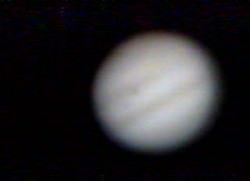Are you ready to stay up a little late and see if you can catch the new dark spot on Jupiter from what could have either been an asteroid or comet impact? It happened somewhere between July 17th and 19th and the scar is still fresh and visible. However, there is just a little bit you need to know to make your viewing the Jupiter impact through your telescope a success.
By July 21, Joe Brimacombe was on this phenomena and recording it. Says Joe: “Got very lucky: CBET 1882 just announced a transient new black spot on Jupiter’s south polar region that it a probable comet impact. By chance I’d been imaging Jupiter between gaps in the clouds and seem to have captured it just before it rotated out of view. Seeing conditions were above average for Cairns.”
And he did a video for us:
Of course, Jupiter and its surface features are one of the easiest targets for backyard telescopes – so seeing something that large – and dark against a light background – should be easy. Right? Wrong. Viewing through our own Earth’s atmosphere plays a huge role on how we see the atmosphere of Jupiter. Low horizon conditions, unsteady or turbulent air, thin clouds, humidity, temperature… all of these are key factors in planetary observing. Observing skills come only with experience, but given the time and effort – you CAN do it!
 Before we go out to look for the impact, let’s stop and talk about Jupiter. There’s a reason so many amateurs love to this fast-rotating disk full of dynamic colored features… Because it’s so easy to see changes! Much like our own skin, the chemical composition of Jupiter’s atmosphere “tans” in the sunlight and the continual motion of its banded weather patterns keep an array of festoons, loops, ovals and barges on display at all times. How difficult is it to spot something? Then know this photo frame of a shadow transit is a 100% realistic view taken by me with a very small telescope with my camcorder. No tweaks, no filters… And it was much clearer to the eye than the camera. However, we need to remember that Jupiter rotates completely in about 10 hours, so a feature you see on its meridian at 11:00 pm won’t be there at 3:00 am. Like the “Great Red Spot”, the whole atmosphere is constantly on the move and there’s no guarantee that something that looks great one night will return again on another.
Before we go out to look for the impact, let’s stop and talk about Jupiter. There’s a reason so many amateurs love to this fast-rotating disk full of dynamic colored features… Because it’s so easy to see changes! Much like our own skin, the chemical composition of Jupiter’s atmosphere “tans” in the sunlight and the continual motion of its banded weather patterns keep an array of festoons, loops, ovals and barges on display at all times. How difficult is it to spot something? Then know this photo frame of a shadow transit is a 100% realistic view taken by me with a very small telescope with my camcorder. No tweaks, no filters… And it was much clearer to the eye than the camera. However, we need to remember that Jupiter rotates completely in about 10 hours, so a feature you see on its meridian at 11:00 pm won’t be there at 3:00 am. Like the “Great Red Spot”, the whole atmosphere is constantly on the move and there’s no guarantee that something that looks great one night will return again on another.
Now, let’s think positively! The impact spot is located near Jupiter’s System II longitude 210°. Although it’s small, if you use a lot of magnification, you should be able to spot it near the pole. The next thing you need to know is when to look! And here are the times the Jupiter impact can be seen for the next 10 days: July 25, 10:54 and 20:49; July 26, 6:45 and 16:41; July 27, 2:36, 12:32 and 22:27; July 28, 8:23 and 18:18; July 29, 4:14, 14:20 and 23:59; July 30, 10:01 and 19:56; July 31, 5:52 and 15:48. For August 1, 01:43, 11:39, 21:34; August 2, 7:32 and 17:25; August 3, 3:23, 13:17 and 23:12; August 4, 9:08 and 19:03; August 5, 4:59 and 14:54; August 6, 0:50, 10:46 and 20:41; August 7, 6:37 and 16:32; August 8, 2:28, 12:24 and 22:18; August 9, 8:15 and 18:20; August 10, 4:06, 14:01, 23:57; August 11, 9:53 and 19:48; August 12, 5:42 and 15:39; August 13, 01:35, 11:31 and 21:26; Auugst 14, 7:22 and 17:17; August 15, 3:13, 13:08, 23:04. Remember, these are very approximate Universal times when it should be visible on the meridian and you should have at least 20-30 minutes of opportunity on either side of the listed time to catch it as it rotates in and out.
Will the impact spot last in the days ahead? Unfortunately, just like the Shoemaker-Levy impact, the atmosphere will shred the debris cloud quickly. It is difficult enough to catch a feature near Jupiter’s poles because of limb darkening – so don’t wait to make your observations. Wishing you clear and steady skies!
Many thanks to Joe Brimacombe of Southern Galactic for sharing his incredible images with us!

